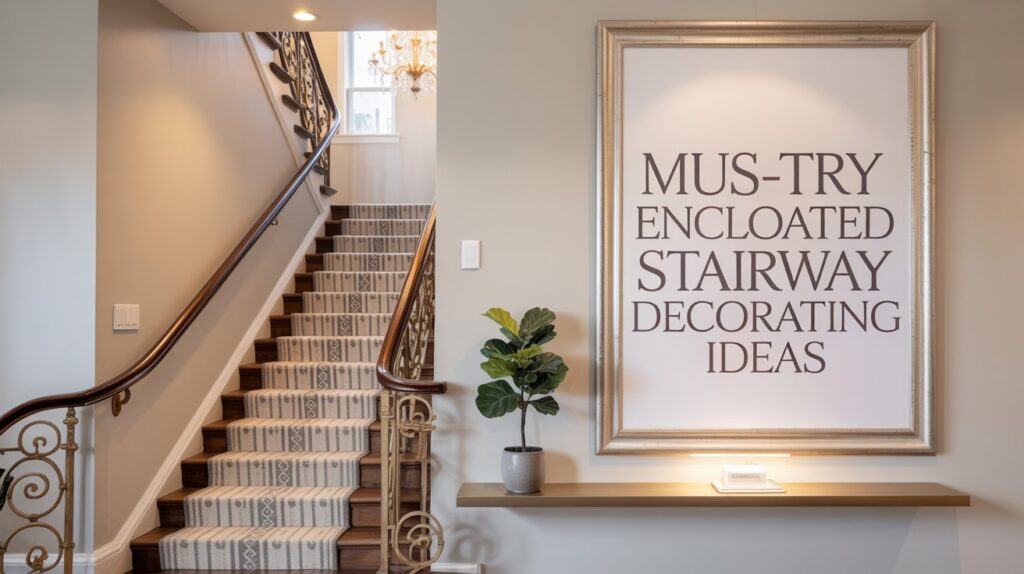Don’t let your enclosed stairway be an afterthought! This narrow space connects your home’s levels, but it doesn’t have to feel forgotten or boring.
Your stairway sees daily foot traffic from every family member. It’s one of the most-used spaces in your house, yet many homeowners ignore its decorating potential. A well-designed stairway can become a highlight of your home instead of just a way to get upstairs.
You’ll learn simple decorating tricks that add style and personality without breaking your budget or requiring major renovations.
We’ve gathered proven ideas that work in real homes. These aren’t fancy designer concepts that look good in magazines but fail in everyday life. Instead, you’ll find solutions that busy families use and love.
By the end of this article, you’ll know exactly how to make your stairway both beautiful and functional.
Must-Try Enclosed Stairway Decorating Ideas
Your staircase doesn’t have to be just a way to get upstairs. I see too many homeowners treating this space like an afterthought. Today, this right approach guide will show you practical ways to enhance your enclosed stairway into something special.
1. Add a Statement Wall with Bold Paint or Wallpaper
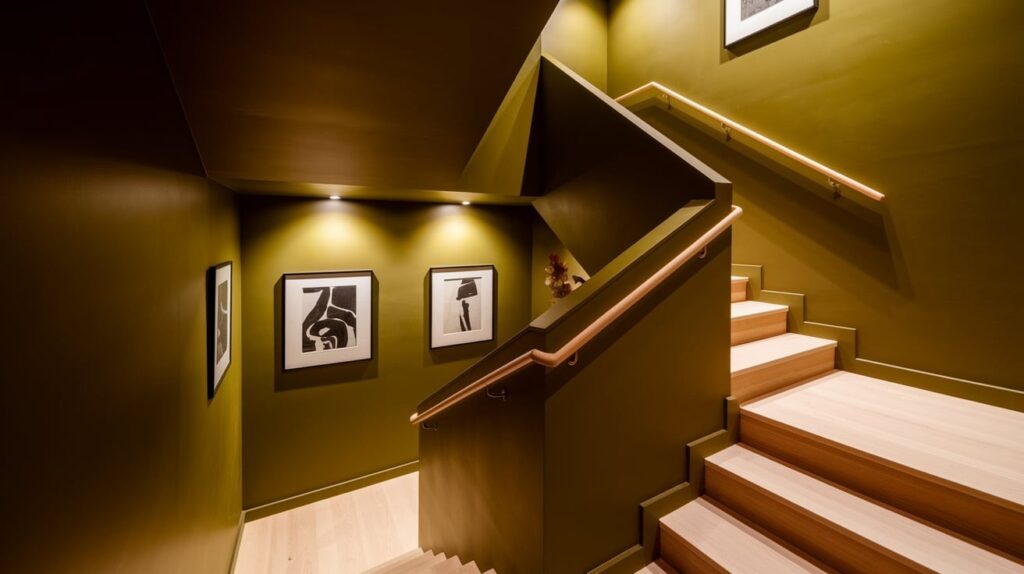
Dark colors work better than you think in small spaces. I recommend deep blues, forest greens, or charcoal gray for stairway walls. These colors create intimacy rather than making the space feel cramped.
Light colors bounce around too much in narrow areas. They can make the space feel flat.
For wallpaper, try vertical stripes to draw the eye upward. Geometric patterns add visual interest without overwhelming the space. Grasscloth textures bring warmth to what can feel like a cold transit area.
Skip busy florals or large-scale patterns. They’ll make your stairway feel chaotic.
2. Incorporate Built-In Shelving or Display Nooks

Built-ins solve two problems at once. You get storage and style.
Consider these options:
- Shallow shelves between studs
- Corner nooks at landing areas
- Under-stair storage with open display space
- Recessed niches for art pieces
I love seeing books arranged by color on stairway shelves. Plants add life to these vertical spaces. Small art pieces create visual stops along your path.
Keep displays simple. Three to five items per shelf work best.
3. Brighten Things Up with Strategic Lighting
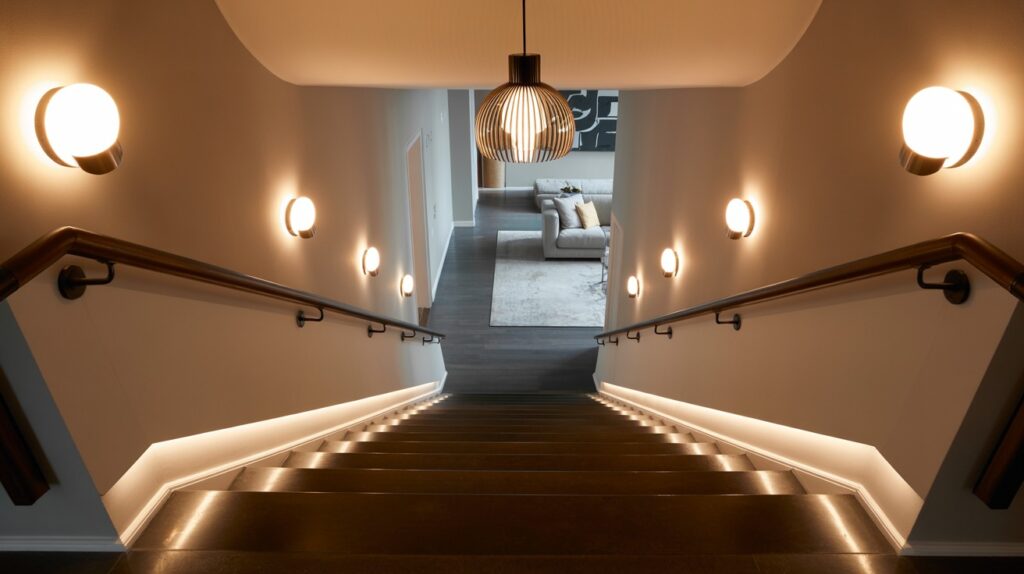
Most stairways are too dark. Poor lighting makes them feel unwelcome and unsafe.
Wall sconces work better than overhead fixtures in narrow spaces. Mount them at eye level, about 60 inches from the floor. Space them every six to eight feet along longer stairways.
LED strip lights under handrails provide subtle guidance without harsh glare. They’re especially helpful for nighttime navigation.
Warm white bulbs (2700 K- 3000 K) create a cozy feel. Cool white feels too clinical for residential spaces.
Pendant lights work if you have high ceilings. Keep them at least seven feet from the floor so tall people won’t hit their heads.
4. Hang a Gallery Wall Along the Staircase
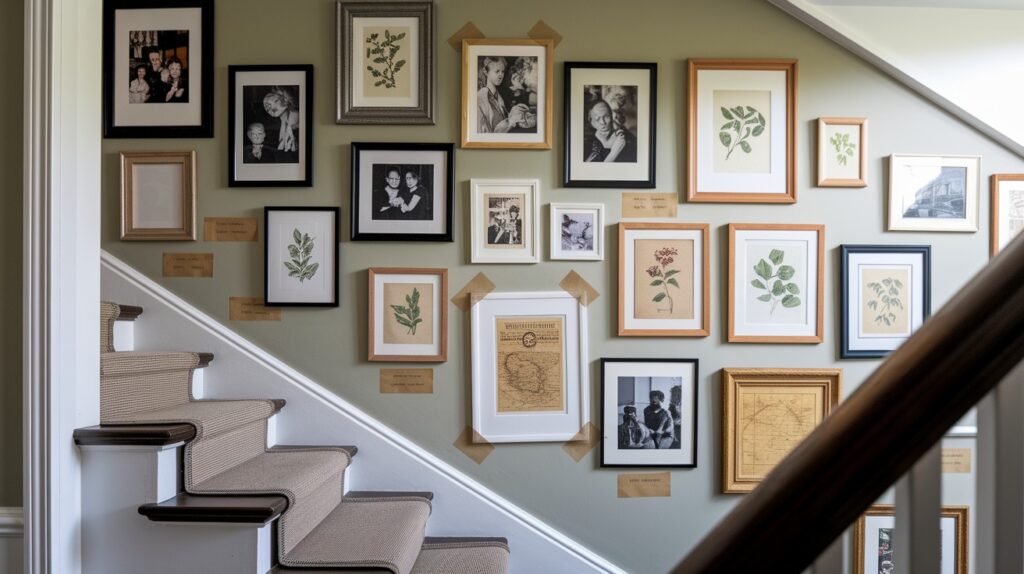
Gallery walls follow the angle of your stairs beautifully. Start with your largest piece and work outward.
Here’s my process:
- Cut paper templates of each frame
- Tape them to the wall first
- Adjust until the spacing looks right
- Mark nail holes through the paper
Mix frame sizes but stick to two or three colors maximum. Black, white, and natural wood create a cohesive look.
Personal photos tell your family’s story. Vintage prints add character. Mix in some unexpected pieces like old maps or botanical illustrations.
Leave 2-3 inches between frames. Closer spacing feels cramped on angled walls.
5. Add a Runner Rug or Carpet for Texture
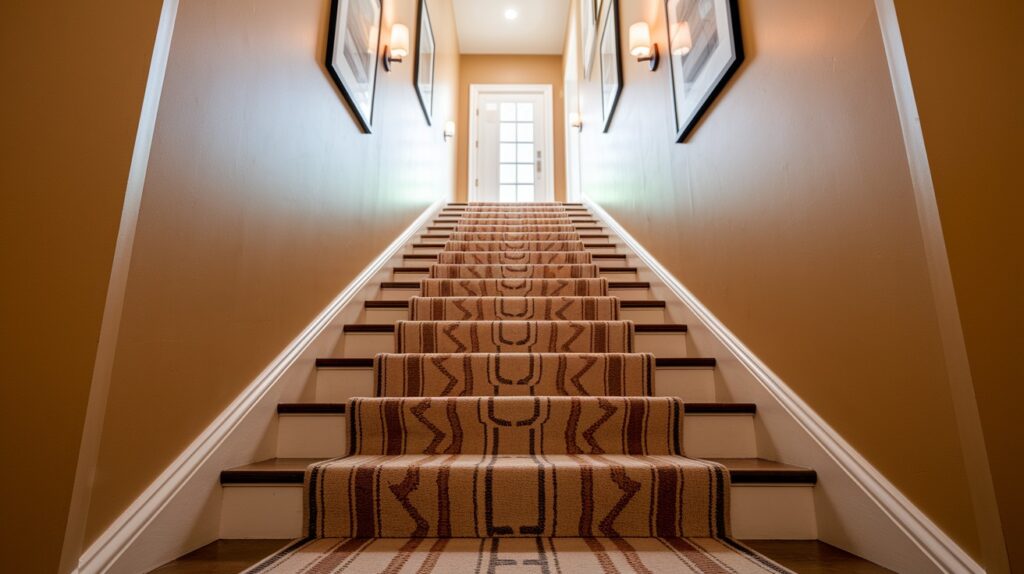
Rugs make stairs safer and quieter. They also soften the hard lines of steps.
For safety, choose low-pile options that won’t cause tripping. Secure them properly with stair rods or heavy-duty adhesive strips.
Bold patterns hide wear better than solid colors. Geometric designs complement most home styles. Traditional patterns work in formal spaces.
Consider your traffic level. High-traffic stairs need durable materials like wool or synthetic blends.
Dark colors show less dirt but can make narrow stairways feel closed in. Medium tones often provide the best balance.
6. Go Green with Hanging or Wall-Mounted Plants
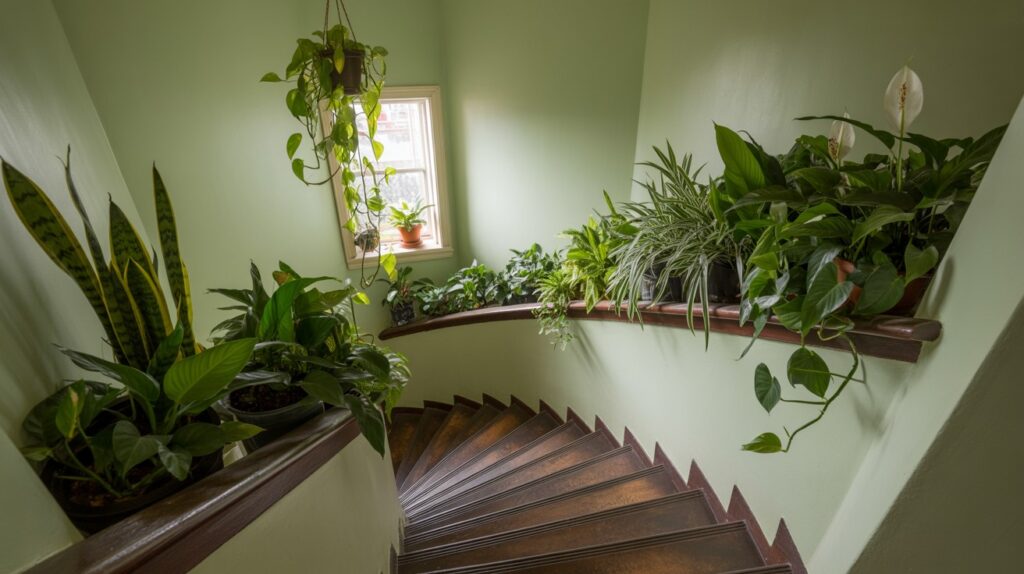
Plants bring life to vertical spaces that often feel sterile.
These varieties handle low light well:
- Pothos
- Snake plants
- ZZ plants
- Peace lilies
- Philodendrons
Wall-mounted planters save floor space. Install them at varying heights for visual interest. Make sure you can reach them for watering.
Hanging plants work on landings or in stairwell windows. Use ceiling hooks rated for the weight of saturated soil.
Group odd numbers of plants together. Three small plants look better than two or four.
7. Frame the Staircase with Trim or Paneling
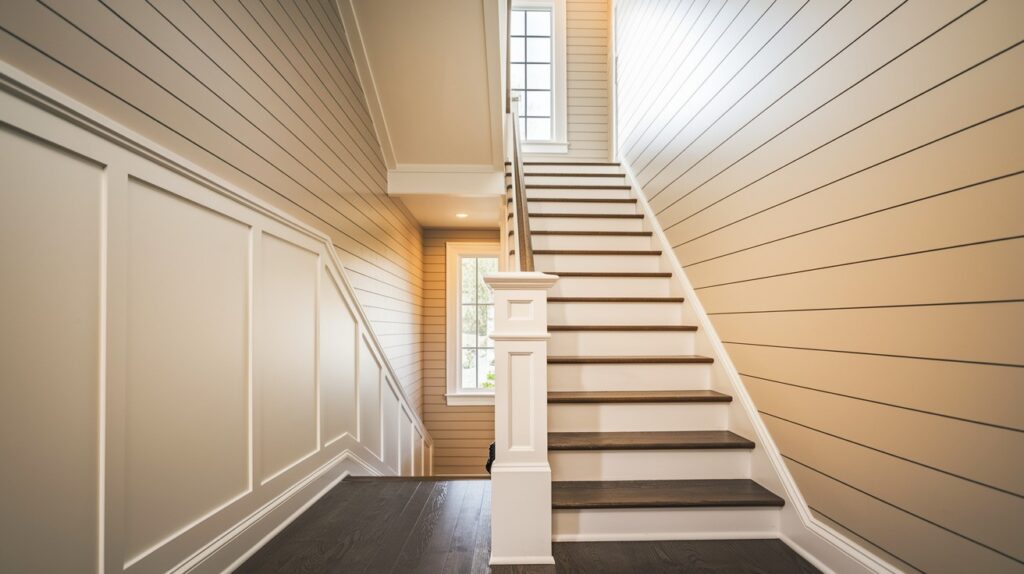
Wainscoting adds instant sophistication to plain stairway walls. Install it about one-third of the way up the wall.
Shiplap creates a modern farmhouse feel. Run it horizontally for a classic look or vertically to emphasize height.
Beadboard works in traditional homes. Paint it the same color as your trim for continuity.
Chair rail molding alone can define the space without full paneling. It’s less expensive and easier to install.
Keep proportions in mind. Wide trim overwhelms narrow stairways. Stick to 3-4 inch widths maximum.
8. Install a Stylish Handrail or Baluster

Your handrail affects both safety and style. Don’t cheap out here.
Metal railings suit modern homes. Black iron creates drama. Brushed steel feels contemporary. Brass adds warmth.
Wood railings work in traditional spaces. Oak and maple are durable choices. Pine is budget-friendly but shows wear faster.
Cable railings provide safety without blocking views. They work especially well in open-concept homes.
Match your railing style to your home’s overall design. A modern cable rail looks out of place in a Victorian home.
9. Use Mirrors to Expand the Space Visually
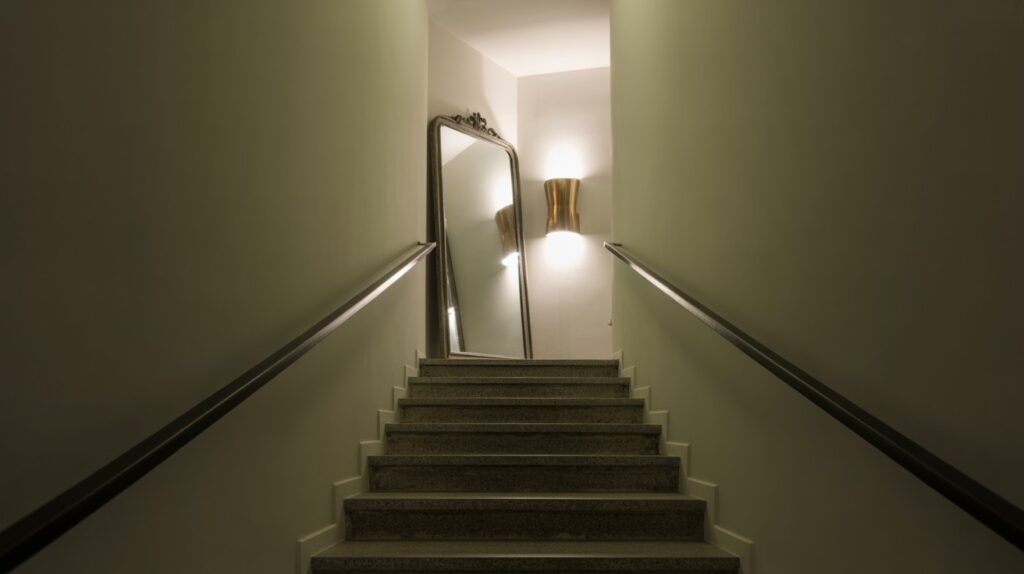
Mirrors reflect light and make narrow spaces feel wider. They’re particularly effective in windowless stairways.
Place mirrors where they’ll catch natural or artificial light. Opposite windows or light fixtures work well.
Large mirrors have more impact than small ones. One substantial mirror often works better than several small ones.
Avoid placing mirrors where they’ll create confusing reflections while walking. You don’t want people getting disoriented on stairs.
Lean mirrors against walls instead of hanging them if your stairway gets heavy use. It’s safer if someone falls.
Conclusion
Your staircase connects your home’s levels physically and visually. These changes will make that connection more intentional and beautiful
Your enclosed stairway doesn’t have to stay bland and forgotten. With these simple ideas, you can turn this everyday space into something that makes you smile each time you walk by.
Start with one small change that excites you most. Maybe it’s adding some artwork or switching out the lighting. Small steps lead to big transformations.
Remember, the best decorating choices are ones that fit your family’s real life. Pick ideas that match how you use your stairway, not just what looks pretty.
Your stairway connects more than just floors but it can connect your home’s style story, too. Take that first step and watch how this overlooked space becomes one of your favorite features.
Frequently Asked Questions
How much should I budget for decorating my enclosed stairway?
You can make a big impact for under $200. Start with paint, lighting, and a few wall decorations. Save money by doing the work yourself and shopping at discount stores for frames and accessories.
What’s the best lighting for a narrow stairway?
Wall sconces work better than overhead lights in tight spaces. They don’t take up headroom and create warm, even lighting. Battery-powered LED sconces are perfect if you don’t want to run new wiring.
Can I hang heavy artwork on stairway walls?
Yes, but use proper wall anchors rated for the weight. Drywall anchors work for lighter pieces, but find the wall studs for anything over 10 pounds. Safety comes first in high-traffic areas.
How do I make a long stairway feel less like a tunnel?
Break up the length with a gallery wall or add mirrors to bounce light around. Light paint colors and good lighting also help open up the space. Consider a runner with a bold pattern to add visual interest.
What decorating mistakes should I avoid in stairways?
Don’t overcrowd the walls or use decorations that stick out too far. Keep pathways clear for safety. Avoid dark colors that make narrow spaces feel smaller, and skip fragile items that could fall and break.

